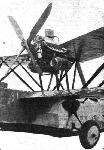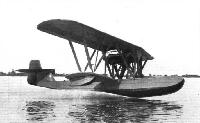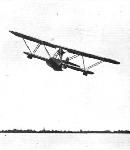
Варианты
- Fokker - B.I / B.III - 1922 - Нидерланды
- Fokker - B.II - 1923 - Нидерланды
Flight, December 1922
THE NEW FOKKER AMPHIBIAN FLYING BOAT
450 H.P. Napier "Lion" Engine
IN September of this year the N.V. Nederlandsche Vliegtuigenfabriek (Fokker) of Amsterdam launched a new machine of somewhat unusual design. This machine, an amphibian flying boat with Napier "Lion" engine, has recently been tested over the Ij, and is said to have given a very good performance. It appears probable that, had the French authorities responsible for the Paris Aero Show not decided to debar the N.V. Nederlandsche Vliegtuigenfabriek from exhibiting this year, the Fokker Amphibian might now have been at the Grand Palais. It may not, therefore, be out of place if we publish in this issue a brief description and some photographs of the machine.
In general arrangement the Fokker Amphibian is a biplane "pusher" flying boat, with a Vee-bottom hull built entirely of Duralumin. To a certain extent it may be said that the hull form resembles that of a Vickers "Viking" but the construction is, of course, entirely different, and the rest of the machine is totally dissimilar. Thus the engine, instead of being mounted between the planes as is usual practice in British flying-boat design, is mounted in the top plane.
By choosing a lower plane of small chord it has been possible to keep the overall height down to a minimum, and as the hull is of fairly large beam the machine possesses a considerable degree of stability on the water. Thus it will be noticed that in one of our photographs, showing the machine at rest on the sea, there is no list, and neither wing-tip float touches the sea.
The boat hull, as already mentioned, is built entirely of Duralumin, having a girder of this metal running along inside and forming a keelson. The hull is covered with sheet Duralumin, and is divided into n watertight compartments, formed partly by the keelson and partly by transverse bulkheads. As in the Vickers "Viking," there are two steps, of which the front one occurs approximately under the centre of gravity, while the rear step is nearly half-way between main step and stern post. The steps are of the open type so as to allow the water to run out easily on taking off.
Although the Fokker Amphibian can be supplied either as a commercial machine or for military purposes, the accompanying photographs show the latter form. There are four seats, arranged as follows :- In the nose is a cockpit for the front gunner; between this and the wings is a second cockpit, in which pilot and engineer are seated side by side, the pilot on the starboard side. Some distance behind the wings is a third cockpit for the rear gunner. The forward cockpit has a set of controls, so that, if necessary, the machine can be piloted from here. When not in use the front controls, and incidentally the gunner's seat, can be folded out of the way.
Communication between the three cockpits is by a tunnel on the starboard side, and the amphibian gear is reached through this from the pilot's cockpit. The wheel axles are hinged on the sides of the hull, and sloping compression struts (telescopic) run from the axle into the top of the hull (through watertight bags), where is situated the gear which raises and lowers the wheels; The handle for operating the landing gear is situated in the pilot's cockpit, and can be reached by either the pilot or the engineer, or even by the front gunner.
The four main petrol tanks, having a total capacity of 600 litres (132 galls.), are placed between the landing gear and the aft gunner's cockpit. A small service tank is mounted in the top plane.
A structure of streamline steel tubes resting on the hull carries in front the two halves of the top plane, while further aft it supports the engine bearers. This structure is so arranged that it is possible to change the engine without interfering in the slightest with the wing structure.
The top plane is characterised by a pronounced dihedral, and is also swept back, while the lower plane has a slight dihedral only. The bracing is in the form of an irregular Warren girder, the sloping members of which are plain double struts, while the vertical (or nearly so) struts are of N formation. Both wings are of wood construction and covered with three-ply. The wing-tip floats are, like the main hull, built of Duralumin.
The Napier "Lion" engine is, as already mentioned, mounted in a cut-out in the top plane, in such a position that it can be easily got at and lifted out by a crane. With its two Lamblin radiators and oil tank it forms a complete unit, and is attached to the tubular structure by four bolts only. A four-bladed "pusher" airscrew is fitted, which consists in reality of two two-bladed screws having thin bosses so as to allow them to be mounted one behind the other on the airscrew shaft.
The tail is of usual type, with a very thick fin, to which is hinged the balanced rudder. The tail plane is of the trimming type, the worm gear being housed inside the fin. Both tail plane and rudder are well clear of the water, and for steering on the sea the tail skid, which is mounted by the rear step, is so shaped as to form a water rudder.
Following are the main characteristics of the Fokker Amphibian: Length o.a., 12 metres (39 ft. 4 ins.); span, top plane, 18-2 m. (59 ft. 8 ins.); span, bottom plane, 10-5 m. (34 ft. 5 ins.); chord, upper, 2-4 m. (7 ft. 10 ins.), lower, 1-8 m. (6 ft.); height, 3-3 m. (10 ft. 10 ins.); weight empty, 1,800 kg. (3,960 lbs.); useful load, 800 kg. (1,760 lbs.); endurance, 4 hours; maximum speed, 125 m.p.h. The machine gets off with full load in 20 seconds.
Описание:
- Flight, December 1922
THE NEW FOKKER AMPHIBIAN FLYING BOAT - Flight, February 1927
THE FOKKER B.III
Фотографии
-
Flight 1922-12 / Flight
THE FOKKER AMPHIBIAN: Front view. Note how machine floats on an even keel.
-
Flight 1922-12 / Flight
A NEW FOKKER AMPHIBIAN: This machine, which has been built for the Dutch Navy, has just undergone its first test flights. The boat hull is built entirely of Duralumin. The engine is a Napier "Lion."
-
Flight 1922-12 / Flight
THE FOKKER AMPHIBIAN: Three-quarter rear view of machine on land.
-
Flight 1922-12 / Flight
THE FOKKER AMPHIBIAN: View showing amphibian gear and mounting of Napier "Lion" engine.
-
Flight 1927-02 / Flight
The Fokker B.III Flying Boat: A recent production from the Dutch Fokker factory. It is fitted with a Napier "Lion," and has a metal hull.
-
Flight 1927-02 / Flight
THE FOKKER B.III FLYING BOAT: Another view of the "Lion"-engined machine in flight.
- Фотографии





